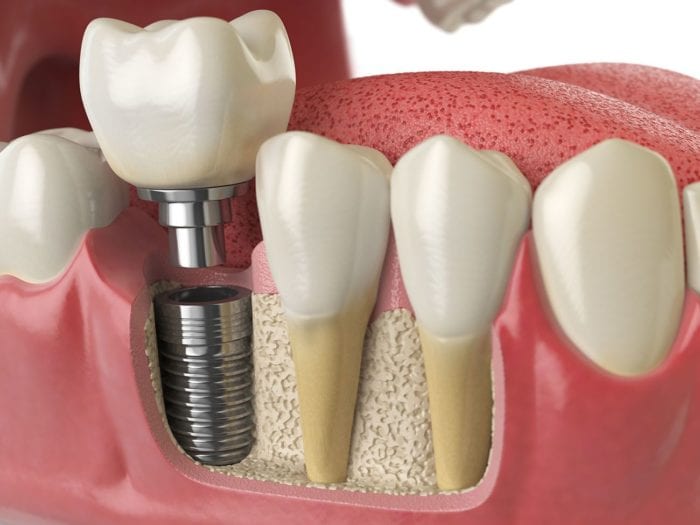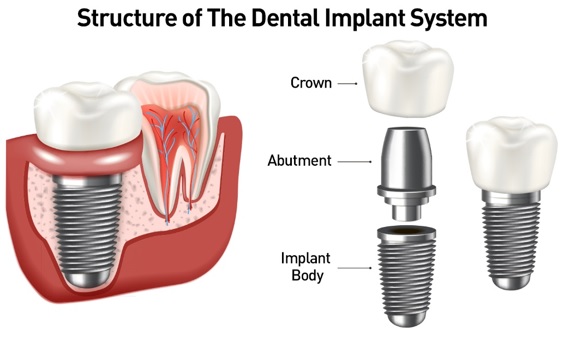The Definitive Guide to Dental Implants
The Definitive Guide to Dental Implants
Blog Article
Some Of Dental Implants
Table of ContentsGetting My Dental Implants To WorkDental Implants for BeginnersDental Implants Fundamentals ExplainedWhat Does Dental Implants Do?
are medical tools surgically implanted right into the jaw to recover an individual's ability to chew or their look. They supply support for fabricated (fake) teeth, such as crowns, bridges, or dentures. When a tooth is shed as a result of injury or condition, an individual can experience difficulties such as quick bone loss, faulty speech, or adjustments to eating patterns that lead to discomfort.
Structure of The Oral Implant System picking oral implants, talk with your oral provider concerning the potential advantages and dangers, and whether you are a prospect for the treatment. Points to think about: Your overall wellness is an important factor in establishing whether you are an excellent candidate for dental implants, for how long it will require to recover, and how long the dental implant may remain in place.
Smoking might affect the recovery process and lower the long-lasting success of the implant. The healing process for the implant body may take several months or longer, throughout which time you normally have a short-term abutment instead of the tooth. the oral implant treatment: Meticulously comply with the dental health guidelines provided to you by your oral supplier.
Get This Report about Dental Implants
Implant failure can cause the need for an additional procedure to take care of or change the dental implant system. Brings back the capacity to eat Restores cosmetic look Helps keep the jawbone from diminishing as a result of bone loss Preserves the health and wellness of the bordering bone and periodontals Aids maintain surrounding (nearby) teeth steady Boosts top quality of life Damage to bordering natural teeth during implant placement Injury to the surrounding tissues throughout surgical procedure, such as sinus perforation Injury throughout surgery (as an example, crack of surrounding jawbone) Insufficient feature, such as really feeling like the teeth do not bite with each other normally A sensation that the tooth is loose or twisting in location arising from a joint screw loosening up Implant body failure (looseness of the implant body) because of systemic infection, which may be most likely in individuals with unrestrained diabetes as a result of neighborhood infection in bone and gum tissues supporting the implant body as a click to read more result of postponed recovery, which may be most likely in individuals that smoke Problem cleaning up the gum tissues around the dental implant, leading to bad dental health Without treatment periodontal disease Post-surgical feeling numb as a result of nerve impingement or damages Always alert healthcare providers and imaging professionals that you have oral implants before any magnetic vibration imaging (MRI) or x-ray procedures.
FDA is not familiar with any kind of unfavorable events reported for MRI or x-ray treatments with dental implants. Oral implants systems are commonly constructed from materials that adhere to worldwide consensus criteria of the International Organization for Standardization (ISO) or ASTM International. These standards have details of what makes a risk-free material.
Other materials such as gold alloys, cobalt-based alloys, titanium alloys, or ceramic materials are often made use of. The safety and security accounts of these products are well-known. Oral implant systems are reviewed according to global agreement criteria. Biocompatibility testing, to show that physical contact with the device does not trigger issues like irritation or allergy, becomes part of the examination that helps ensure the materials in the oral implant system are secure and do not trigger adverse effects when Going Here implanted in individuals.

An Unbiased View of Dental Implants
Some people are not eligible for oral implant surgical procedure. It is for oral doctors to operate people with: severe illnessuncontrollable metabolic diseasebone or soft cells illness or infectionIf these problems are resolved, a person can have the surgical treatment. Dental Implants. In, oral specialists avoid operating on people with: If people with any of the above undertake oral implant surgical treatment, there is a greater threat of the implant falling short
Some people have a jawbone abnormality that avoids adequate bone for an implant from establishing. In such instances, a doctor might need to carry out a ridge alteration. This entails lifting the gum tissue to reveal the location of warped bone. The doctor will certainly then use a bone or bone alternative to repair and accumulate the area.
Oral implant surgical procedure is a personalized process. It's not the very same for everybody. The complying with provides a general introduction of what you can anticipate your dental practitioner, oral specialist, periodontist or prosthodontist to do: Place the implant operatively. Provide you time to heal. Attach the blog post and final crown, bridge or denture.
Next, your surgeon will carefully position the oral implant right into your jaw. Ultimately, your surgeon will reposition your periodontals and shut the laceration with stitches. If your dental implant is near the front of your mouth, your dental expert will certainly make a temporary tooth for you to use up until you heal. In this way, you won't have a space in your smile while you recover.
7 Simple Techniques For Dental Implants
Your provider can inform you what to expect in your situation. During the recovery phase, your jawbone ought to fuse to the dental implant. This procedure, called osseointegration, is important for stability and long-lasting success. This process can take anywhere from three to nine months. In many cases, it may take much longer.
When your implant heals, your dental practitioner can attach the joint (small adapter article) and your last reconstruction (crown, bridge or denture). This generally takes regarding one hour to finish and may need a second small surgery. You should not feel any kind of discomfort throughout your oral implant procedure due to the fact that your service provider will use medication to numb your periodontals.
Report this page